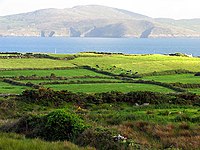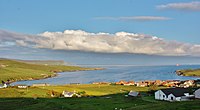User:Glitter/Caldia
Kingdom of Caldia Ríocht na Glaíteann | |
|---|---|
| Motto: "Ar son an rí agus saoirse" "For King and Liberty" | |
| Anthem: "Glaoch an Glaíteann" "Caldia's Call" | |
 Caldia (dark green) in Euclea (light green and light grey) and in the Euclean Community (light green). | |
| Capital and largest city | |
| Official languages | Ghaillish |
| Ethnic groups | no official statistics |
| Demonym(s) | Caldish · Caldian |
| Government | Unitary parliamentary constitutional monarchy |
• Monarch | Kenneth IV |
| Stiofán Mac Suibhne | |
| Legislature | Tionól |
| Establishment | |
• A unified Ghaillish kingdom established | 720 CE |
• Kingdom of Caldia established | 1017 |
• Joined the EC | 1 January 1955 |
| Area | |
• Total | 222,029 km2 (85,726 sq mi) |
| Population | |
• 2022 estimate | 10,177,695 |
• 2013 census | 9,257,180 |
• Density | 41.69/km2 (108.0/sq mi) |
| GDP (PPP) | 2013 estimate |
• Total | $624.350 billion |
• Per capita | $67,445 |
| GDP (nominal) | 2013 estimate |
• Total | $645.512 billion |
• Per capita | $69,731 |
| Gini (2018) | low |
| HDI (2018) | very high |
| Currency | Euclo (EUC (€)) |
| Time zone | Euclean Standard Time |
| Date format | dd-mm-yy |
| Driving side | right |
| Calling code | +66 |
| ISO 3166 code | GLT |
| Internet TLD | .gl |
Caldia (Ghaillish: Glaíteann), officially the Kingdom of Caldia (Ghaillish: Ríocht na Glaíteann), is a sovereign nation located in Northern Euclea. It is completely surrounded by water, made up by the Caldish Isles. Caldia has an estimated 10 million inhabitants. The capital and largest city is Spreglen. It has a low population density of 41.7 inhabitants per square kilometer (108/sq mi), with the highest concentration on the country's southern coast. Approximately 85% of the population lives in urban areas. Southern Caldia is predominantly agricultural and urban, while the north is heavily forested and mountainous, particularly in the Highlands.
The country is also renowned for its natural beauty and hosts a tourism industry. The Caldish Highlands are one of the most visited regions of the country. The island of Holyhead also sees thousands of visitors each years and is known for its beaches and gambling industry. The climate and environment varies significantly throughout the country. In the south, the climate is mild due to maritime influence. It has warm continental summers and cold, snowy winters. The north is characterized by its mountains and sea lochs.
Tenic peoples have inhabited Caldia since prehistoric times, emerging into history as the Ghailles. Caldia emerged as a unified country for the first time in the 11th century. It played an important role in the North Sea region during the Middle Ages, with influence peaking during the Marauder Age. After unification, it has been involved in several major civil wars and has participated in a number of Euclean and colonial conflicts. Due to its historical adversary with Solarian Catholic Church, Caldia was one of the first to break with Solaria during the Amendist Schism. It fought during the Amendist Wars on the Amendist side and had to quell domestic unrest. Caldia was a colonial power, establishing oversees dominions in Asteria Superior during the seventeenth century. The last war Caldia was directly involved in occured in the 18th century. Democratic governance was first introduced in a limited capacity in 1814 and was universally expanded in 1857 through the Silent Revolution. Though it was formally neutral throughout the Great War, Caldia was occupied by the Grand Alliance. Caldia became a member of the Euclean Community in 1955. Since, Caldia has maintained its official policy of neutrality despite membership in the EC. It joined the Euclozone upon its founding.
Today, Caldia is a constitutional monarchy with a unitary, parliamentary system of governance, consisting of ten provinces. The current Monarch is Kenneth IV, who acts as the head of state. Executive power is exercised by the government, chaired by the taoiseach, currently Stiofán Mac Suibhne. Legislative power is exercised by the unicameral Tionól.
The country is well known throughout the world for its long record of promoting extensive civil and human rights and its bold steps in order to create equal opportunity for all throughout the world. The nation takes a multilateral approach to foreign affairs, working within the structures of the international organizations to which it belongs. The government pursues an active foreign policy and is frequently involved in peace-building processes around the world. It is a leading advocate for nuclear disarmament. It maintains an official policy of neutrality in foreign affairs and is not a member of a military organization. Caldia has one of the longest records for peace in the world, having not been in a state of war for over 300 years. The nation is an active member of theCommunity of Nations. It is also a member of the Northern Forum, the International Trade Organisation, and the Global Institute for Fiscal Affairs. It hosts a number of international institutions, including offices for the Community of Nations.
Caldia ranks high in several metrics of national performance, including government transparency, civil liberties, economic competitiveness, and human development. Many adult citizens tend to be among the wealthiest in the world in both financial and non-financial assets. The Caldish education system is a major component in the country's status in global prominence and contributes to the growth of the economy as well as the overall quality of life for the Caldish. It is is considered one of the happiest countries in the world and boasts one of the highest life expediencies in the world. Major cities have been ranked among the top cities with the highest quality of life in the world. Caldia is often regarded as a tax haven for foreigners and foreign businesses.
Etymology
Caldia is derived from the tribal name Caledones (or Calīdones), which is etymologized as "'possessing hard feet', alluding to standfastness or endurance", from the Proto-Tenic roots *kal- "hard" and *φēdo- "foot". The Caledones were a tribe living on the southern coast of the main island. They were encountered by the Solarians, who in turn named the island chain after them. It was Solarianized as Calidonia, which was later Estmericized to Caldia. This is reflected in the Solarian-influenced languages. The name Calidonia is rarely used in modern contexts, but it is used to describe the religious denomination of the Church of Caldia. Historically, a person from Caldia was referred to as Calidonian in early Euclean written records. Overtime, this was shortened to Caldian but this has mostly fallen out of use. People from Caldia are today described as the Caldish.
The Ghaillish name for the country is Glaíteann. There is some disagreement about the meaning of the name. It is widely speculated to have been derived from "shinning land" in old Ghaillish. The modern Ghaillish word glioscarnach means "shining". It is believed the first three letters are used to form the first component of the name: Glaít-. The second component is believed to come from lann or ferann meaning "land". It is also believed that -eann is a genitive suffix for either lann or ferann.
However, this theory is criticized by some academics who note the lack of explanation for the additional letters in Glaíteann not found in either component. Others note that glioscarnach was not commonly used until middle Ghaillish. Caindlech and lainnerda were commonly used as the words for "shining" in old Ghaillish. The exact origin of the name Glaíteann remains disputed, but no alternative theory with wide backing has emerged. The first time Glaíteann was seen in a written source was the 9th century.
The first time the country was mentioned in a written source was in 96 CE. The Solarian author Jermone describes the Caledones and Calidonia in Borealia. A 9th Solarian manuscript from the Verliquoian court used the name Calidonia while an Estmerish chronicle from the late 12th century mentions Caldia. This is the first time the name Caldia appears in a written source. In Gaullican, Caldia is known as Calidonie, derided from the Solarian Calidonia. Weranic sources from the 7th century used Nordlant (literally North-land) as the name for modern-day Caldia. Old Scovernois records refereed to the Caldish Isles as Gadland (literally Gaídel-land) which remains the current name for Caldia in the Scovernois languages.
Geography
Caldia occupies the entirely of the Caldish Isles, an archipelago located off of the northeast coast of Euclea. The archipelago has six main islands with the majority of the population living on the main island. It is bounded to the east by the Vehemens Ocean, the southwest by the Northern Sea, the northeast by the Ghaillish Sea, and to the northwest by the Boreal Sea. The country shares a maritime border with Scovern, Werania, and Blostland.
At 222,029 kilometers squared (85,726 sq mi), Caldia is the thirteenth-largest country in Euclea. It is the among the northernmost points in Euclea and is one of the coldest. Caldia's highest point is Mór Ealadha, at 2,111 m (6,926 ft) while the lowest point is Gleann Naofa in Adhmadfiáin, the lowest point of which is 5 meters (16 feet) below sea level.
Southern Caldia, which is home to the largest portion of both the country's population and agricultural land, is broadly comprised by temperate grassland and mixed forest, while further north boreal forest predominates. In Sudreadharr, the Highlands, and the northern portions of the Lowlands, there is a large Taiga biome and that features concentrated populations of Caldish pine. Mountain ranges are also common throughout the Highlands. The Caldish landscape is marked by the effects of former ice age glaciation, which formed lakes and the characteristic jagged, rocky northern coastline, marked by hundreds of small islands. Sea lochs are common along its northern coastline.
A pasture near Coolnahorna, County Bouladuff
Lú Ethniu, County Sackmannan
Plains of Killeena, County Shillelagh
Mór Ealadha, County Ballina
Beaches in Pennsea, County Holyhead.
Uisceard nature reserves in Shangarry, County Taois
The New Quay, Crainnbeagy, County Oileáin Oirthir
The River Twinc, County Folcthagh
A sea-loch located in County Liathróidí
Arianaid Bay, off the south coast of County Caithia












